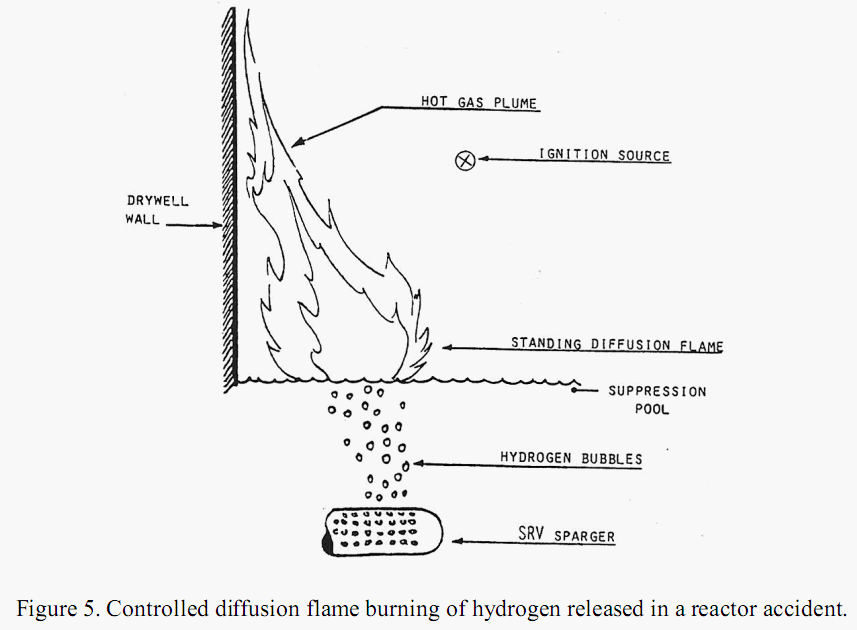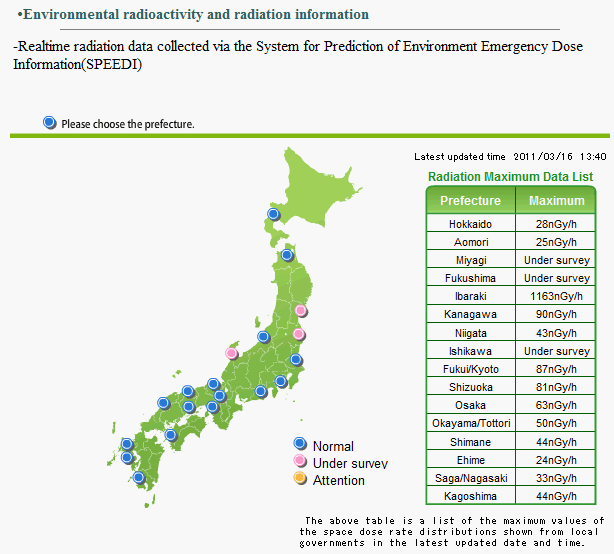
Alphonso
-
Posts
13 -
Joined
-
Last visited
Content Type
Events
Forums
Downloads
Quizzes
Gallery
Blogs
Posts posted by Alphonso
-
-
No, there is no system to ignite the hydrogen. The idea is not to ignite it! The explosions earlier in the week were accidental ignition, either from an electrical spark or from pyrophoric compounds in the vented gases (uranium itself is pyrophoric when finely divided). The hope is that the hydrogen dissipates naturally without igniting. They have knocked holes in the upper walls of reactors 5 and 6 to facilitate dispersal of any hydrogen gas.
As I understand, the plant does not generate hydrogen in normal operation. They believe the hydrogen came from water (steam) reacting with (accidentally) exposed fuel rods. So there isn't a system in place to dissipate the hydrogen safely that I am aware of. Apart from knocking holes in the wall....
The reason I ask is from this document https://netfiles.uiuc.edu/mragheb/www/NPRE%20457%20CSE%20462%20Safety%20Analysis%20of%20Nuclear%20Reactor%20Systems/Containment%20Structures.pdf which shows

and mentions recombiners. Just wondering if this is applicable to these reactors. I can not help think there would be some contingency to get rid of the hydrogen in a safe manner although in the case of Fukushima that may not have been possible due to the nature of failures caused by the tsunami.
-
True at the top of the building..... But bear in mind that the plant is partly underground. And they were considering venting the reactor into the pressure suppression pool. Which is the toroid structure at the bottom. An explosion down there could potentially send the core shooting up into the air like a rocket

Something I've been wondering about. Is the suppression pool supposed to have an igniter to burn off the potentially dangerous hydrogen gas and if so is there no backup way of safely venting should the ignition system fail?
-
That's an interesting point/question below, Alphonso... I hadn't considered that before...
Sorry, I was going by the red dots as being the 2 stations which seem about 10km apart. After some google measuring center to center of reactors at stations 1 & 2 appear to be 12km. The circles look right, 20km & 30km radius, my bad.
-
I believe I've finally come across the real and official radiation readings for areas around the Fukushima Site, including the readings that document the NHK report earlier today about the town of Namie...
Seems that 20km and 30km area in red is the diameter! So anything in the 30km zone is at most 15km from the reactors.
-
I don't think it has come up today but the readings at http://www.bousai.ne.jp/eng/ seem to be lower across the board again, with Ibaraki now at 650nGy/h (0.65 microsievert/h), down from about 750/850/950 last three days.
Ibaraki prefecture info can be found here http://www.ia-ibaraki.or.jp/kokusai/english/index.html
Horiguchi reported at 0.538µSv as of 19-Mar 16:00 local time. KitaIbaraki-shi 0.891µSv.
-
I'm still trying to get the full report in pdf file off the web site link you posted... Very slow to download... Perhaps many people interested in it.
Here are some of the reports I've placed on a file server.
-
NHK just did a report on the Japan Govt's radiation monitoring results for today (Saturday) from 28 locations around the Fukushima plan in a 30 to 60 Kilometer radius...
At least one of the results -- the highest -- is surprisingly bad... The town of Namie northwest of the plant measured at 0.136 micro-sievert per hour...
With 720 hours in a month, if someone was staying outside continuously, that works out to an exposure of 98 mSv per month, or more than 3 mSv per day... which would be a cause for health concern.
(136 microsievert X 720 hours in a month = about 98,000 microsievert, or 98 millisievert per month)
That reading was taken at 10:20 am Saturday...and was lower than a 140 microsievert measurement taken at the same location the day before (Friday).
Looks like Namie is a little less than 10km NNW of the reactor site.
Here are some more figures for Fukushima prefecture.

Info can be found here http://www.worldvillage.org/fia/kinkyu_english.php
-
But then, 1 Sievert is equal to 1000 milli Sievert, right? This is giving me a headache...

.can one of you guys post the formula for converting those to milli sieverts again.
This one is easy - one Gray (Gy) = 1 Sievert, so they can be considered interchangeable numerically. radprocalculator
Numbers are in nanoGray so divide by 1,000 for microSv or divide by 1,000,000 for milliSv.
From http://www.world-nuclear-news.org/RS_Second_fire_reported_at_unit_4_1603111.html
Chief Cabinet Secretary Yukio Edano has described problems that occurred on the morning of 16 March with Fukushima Daiichi 3 and 4. He also outlined plans to pump water into unit 4.At 8:34am local time white smoke was seen billowing out of Fukushima Daiichi 3. Efforts to determine the cause of this development were interrupted as all workers had evacuated to a safe area due to rising radiation readings. Readings from a sensor near the front gate had fluctuated for some time, although Edano said that on the whole there was no health hazard. Earlier in the morning readings had ranged between 600-800 microsieverts per hour, but at 10am readings rose to 1000 microsieverts per hour. Readings began to fall again from around 10:54.
If readings are quoted without knowing where they were taken from i.e. the gate or at the reactor itself, it can make for a lot of confusion.
-
NHK:
Radioactivity forecast system down
A computer system that forecasts the spread of radioactivity has not been working due to malfunctioning monitoring posts around a troubled nuclear power plant in quake-hit Fukushima Prefecture.
The Nuclear and Industrial Safety Agency says it does not know when the system will be back in operation.
The system, called SPEEDI, predicts how radioactive substances will spread in case of radiation leakage from nuclear power plants, based on measurements taken at various locations, prevailing winds and other weather conditions.
SPEEDI data are intended to be used to draw up evacuation plans for residents around power plants in case of accidents.
The system is monitored at government offices, including the industry ministry and the Nuclear and Industrial Safety Agency in Tokyo.
Friday's earthquake caused power outages around the troubled Fukushima Daiichi nuclear power plant.
The agency says it cannot expect the SPEEDI system to function fully, since many monitoring posts are not operating due to power outages.
Wednesday, March 16, 2011 10:25 +0900 (JST)
Haven't seen levels for Fukushima but for Ibaraki
Disaster Prevention and Nuclear Safety Network for Nuclear Environment Real time radiation data collected via SPEEDI 2011/03/16 12:10 Ibaraki Space Dose Rate List(nGy/h) Ishigami 810 Toyooka 516 Funaishikawa 231 Yokobori 366 Oshinobe 391 Muramatsu 361 Mawatari 421 Onuki 356 Hiroura 494 Tsukuriya 377 Araji 297 Hitachinaka 575 Ajigaura 388 Ishikawa 284 Horiguchi 1240 Kuji 813 Isobe 485 Kadobe 703 Sugaya 283 Oba 215 Ebisawa 268 Sawa 845 Yanagisawa 364 Motokomezaki Under servey Nukada 360 Kounosu 420 Godai 468 Onuma 526 Mayumi 391 Uridura 198 Nemoto 262 Kume 151 Isohama 289 Tasaki Under servey Momiyama 614 Yatabe 237 Yoshizawa 238 Kamitoda 197 Tokushuku 185
And for overall showing maximums where available.

The site seems overwhelmed so I won't add a link here.
-
Why have no back up generators or pumps with other power sources been dropped in by helicopter.
No doubt there exist large trucks with generators the size of shipping containers.
Multiples could be chained through regulators to provide enough power for most large jobs, why not here?
Why are these resources not in evidence????
I think you may have underestimated the severity of the damage caused by the tsunami.
http://bravenewclimate.com/2011/03/12/japan-nuclear-earthquake/
It seems that Fukushima design basis tsunami was 6.5 meters, but the actual tsunami was in the 7-8 meter range. These waves washed the diesel fuel system away, submerged the switchyard and destroyed most of the switchgear. This massive damage to the electrical system prevented rapid hookup of auxiliary diesel generators that were relatively quickly brought on site. So only the turbine driven battery controlled RCIC was available to inject water into the reactor vessel until AC power was restored to the HPCI.and http://www.greenaction-japan.org/modules/wordpress1/index.php?p=2
A problem occurred at 20:30 when the M/C (Main Switchboard) was submerged underwater. This prevented proper monitoring of pump operations and the reactor’s water levels. The situation had to be managed without proper information from the site.Idk how many senors/instruments are inoperative but IMHO I think the people there are doing the best they can under the circumstances. Perhaps even to the extent of making the ultimate sacrifice to try and avert more suffering and death elsewhere.
-
Interestingly, I haven't seen one Japanese news report mentioning the TEPCO worker who died the other day at the Daini plant after being somehow stuck up in a reactor crane near one of the exhaust stacks...
Likewise, I haven't seen any explanation of just how they managed today to run out of fuel to power the pumps at Daiichi Reactor No. 2 this afternoon, allowing the fuel rods to go entirely exposed for more than two hours...
Full information seems lacking maybe a case of need to know, idk. From the bits and pieces posted I'd have to guess the crane operator was in the crane cab inside the building of reactor one when the first explosion occurred.
Would have thought there might be some way to burn off the vented gas through a flare stack but maybe not or because damage to the site has resulted in failure of a number of systems.
Still many unanswered questions but post #442 looked promising, lets hope they are finally making progress.
Some info http://www.world-nuclear-news.org/RS_Venting_at_Fukushima_Daiichi_3_1303111.html
-
Not correct...
National Police Office Order No. 606/2006
7.17
(6) In case of the applicant who is married to a Thai wife, one of them or both of them need to have the total annual income that is averaged out not less than 40,000 Baht per month. Except for the case that the said foreign national has entered Thailand before this Order is enforced and the foreign national has been permitted to stay in the Kingdom by the result of having married to a Thai wife, then if the applicant does not have the said income, then, the latest 3 months records of the account book of any Bank in Thailand with the account name of either or both parties need to have the amount of money not less than 400,000 Baht.
As you applied before this order was enforced ( Oct. 1st, 2006), the income requirement does not apply to you.
www.sunbeltasiagroup.com
Sunbelt, please clarify the above. It seems to state :-
"Except for the case that the said foreign national has entered Thailand before this Order is enforced and the foreign national has been permitted to stay in the Kingdom by the result of having married to a Thai wife"
In other words, if the foreigner has entered the Kingdom before 1st of October (September for example) and has a valid 'O' visa + 400k for 3 months, then he can apply after 1st Oct under the older law. Since the requirement used to be that you had to be in the country 45 days before you could apply then this would make sense. Also applying for the extension only granted 'consideration', and one would have to wait further still before getting approval, so applying doesn't constitute the granting of said extension. Of course I may be out of date with these reg's or something has been lost in the translation, would you please confirm if this is correct.
Great work by the way...

Meltdown Likely Under Way At Japan Nuclear Reactor
in World News
Posted
Post removed due to data below.